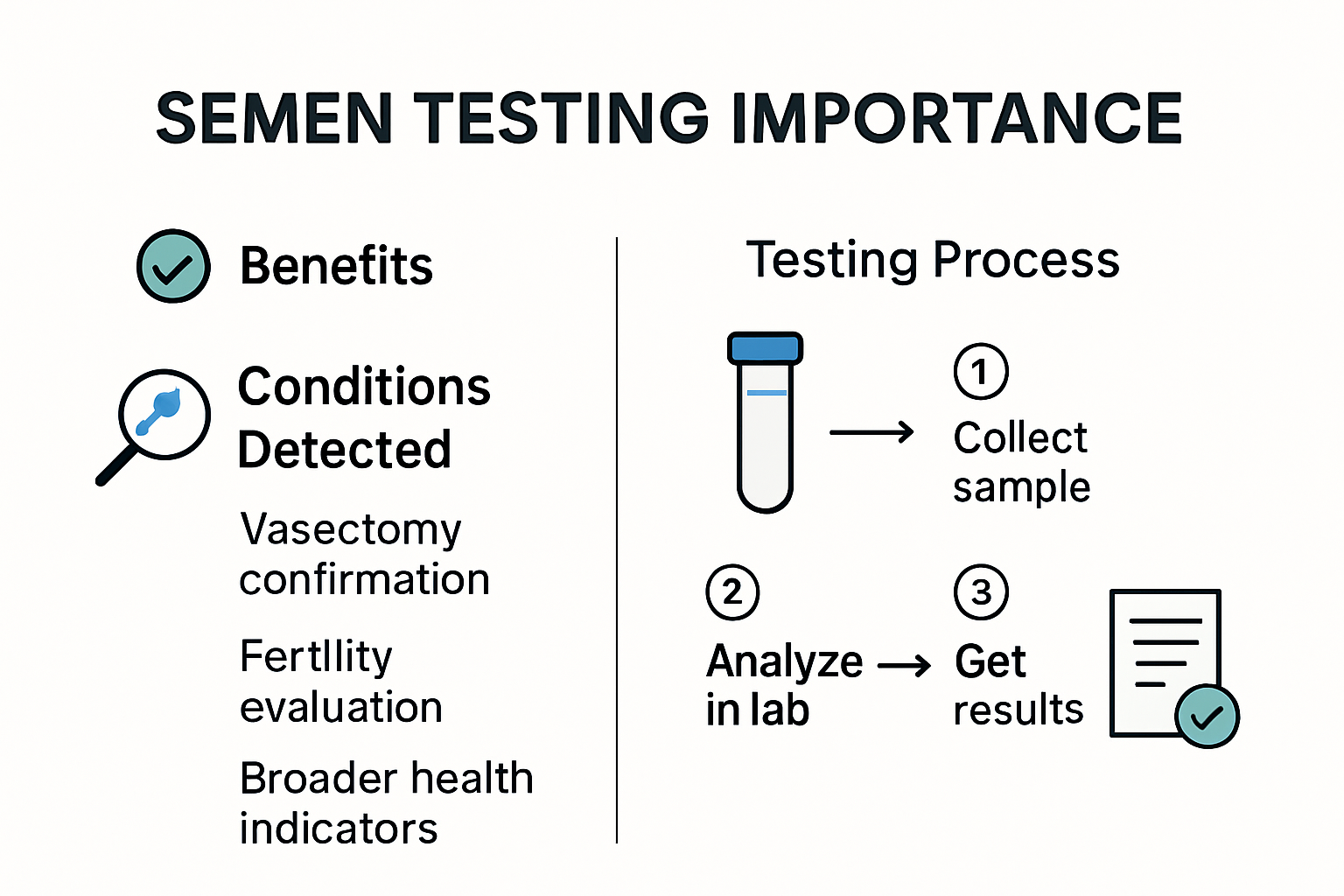Semen testing holds the key for men seeking clarity after a vasectomy or answers about fertility. Surprising as it sounds, even after the procedure, up to 9 percent of men can still have sperm present in their ejaculate in the early months. That flips everything you might assume about a quick fix for permanent birth control. Instead, medical science insists that only a laboratory semen analysis can actually prove when sterility is achieved. This simple test not only closes the chapter on worries about unintended pregnancy, but it can also help spot hidden health issues long before any other symptoms appear.
Table of Contents
- How Semen Testing Confirms Vasectomy Success
- The Role of Semen Analysis In Fertility Planning
- What To Expect During A Semen Sample Test
- Key Reasons Urologists Recommend Semen Testing
Quick Summary
| Takeaway | Explanation |
|---|---|
| Semen testing is essential for confirming vasectomy success | Post vasectomy semen analysis (PVSA) is crucial to verify that no viable sperm remain, ensuring effective male sterilization. Multiple tests are recommended for absolute confidence. |
| Semen analysis provides valuable insights for fertility planning | It assesses sperm count, motility, and morphology, helping to identify fertility challenges and underlying health issues, thus guiding potential interventions. |
| Home semen testing enhances accessibility and privacy | Modern home testing technologies allow individuals to collect samples in a comfortable environment while still providing lab-grade analysis, facilitating proactive health management. |
| Semen testing serves as a preventative health screening tool | Beyond fertility evaluation, it can indicate broader health issues, such as metabolic or cardiovascular problems, prompting earlier intervention and lifestyle changes. |
| Preparation is key for accurate semen sample testing | Patients should follow specific guidelines, including abstaining from sexual activity prior to testing, to ensure optimal sperm concentration and accurate results. |

How Semen Testing Confirms Vasectomy Success
Confirming the success of a vasectomy requires precise scientific verification through semen testing. While the surgical procedure seems straightforward, determining absolute sterility demands meticulous analysis. Semen testing provides the definitive proof that no viable sperm remain in the ejaculate, transforming a medical procedure from theoretical to conclusively successful.
Understanding Post Vasectomy Semen Analysis
A post vasectomy semen analysis (PVSA) represents the gold standard for confirming male sterilization. Our comprehensive guide on vasectomy success details the critical steps of this verification process. Typically, urologists recommend waiting at least two to three months after the vasectomy before conducting the first semen test. This waiting period allows sufficient time for remaining sperm to clear from the reproductive tract.
The analysis focuses on one primary metric: sperm count. According to research from the University of North Carolina, a successful vasectomy requires zero sperm in the ejaculate. Interestingly, a 2016 clinical study found that sperm presence can range from 0.3% to 9% in the months immediately following the procedure, underscoring the absolute necessity of professional testing.
The Science Behind Semen Testing Accuracy
Semen testing goes beyond a simple visual examination. Professional laboratories conduct detailed microscopic analysis to detect even trace amounts of sperm. The process involves centrifuging the sample, preparing specialized slides, and using high-powered microscopes to count potential sperm cells. Professional grade tests can detect as few as one sperm per milliliter, providing unprecedented accuracy.
The Cleveland Clinic emphasizes that multiple tests might be required to confirm complete sterility. Most medical professionals recommend at least two consecutive tests showing zero sperm count, typically spaced several weeks apart. This approach ensures that no residual sperm remain in the reproductive system and eliminates any potential for unexpected fertility.
Understanding why testing is crucial cannot be overstated. Without proper verification, couples risk unintended pregnancy. A semen test transforms a vasectomy from a theoretical procedure to a confirmed method of permanent contraception. The test provides peace of mind, definitively answering the critical question of whether the vasectomy has successfully prevented future conception.
Key considerations for accurate semen testing include proper sample collection, timely transportation to the laboratory, and following all provided instructions meticulously. Home testing kits have revolutionized this process, offering privacy and convenience while maintaining professional medical standards. By bringing laboratory-grade testing directly to individuals, these innovations make confirming vasectomy success more accessible than ever before.
The Role of Semen Analysis in Fertility Planning
Semen analysis emerges as a critical diagnostic tool in modern fertility planning, offering couples comprehensive insights into male reproductive health. Far more than a simple medical test, it provides a detailed roadmap of potential fertility challenges and opportunities. Explore our guide on understanding semen analysis terms to gain deeper comprehension of these complex medical evaluations.
Understanding Semen Quality Parameters

A comprehensive semen analysis evaluates multiple critical parameters that directly impact fertility potential. Sperm count represents the foundational metric, measuring the total number of sperm cells per milliliter of semen. According to research from Houston Methodist, these parameters extend beyond reproductive capabilities, potentially revealing underlying health conditions like metabolic disorders and cardiovascular risks.
Beyond quantity, sperm motility and morphology play crucial roles. Motility determines the sperm’s ability to navigate through the female reproductive tract, while morphology assesses the sperm’s structural integrity. Abnormalities in these parameters can significantly impact conception chances. Medical professionals typically consider a sample normal if it contains at least 15 million sperm per milliliter, with 40% demonstrating progressive movement.
Fertility Planning and Proactive Health Screening
Semen analysis transcends traditional fertility assessment, emerging as a comprehensive health screening tool. Clinical studies from leading reproductive health institutions indicate that semen quality can serve as an early indicator of broader health conditions. Reduced sperm parameters might signal potential metabolic issues, hormonal imbalances, or systemic health challenges that require further medical investigation.
For couples attempting to conceive, semen analysis provides actionable insights. It helps healthcare providers develop targeted intervention strategies, whether recommending lifestyle modifications, hormonal treatments, or advanced reproductive technologies like intracytoplasmic sperm injection (ICSI). The test offers a precise understanding of male fertility potential, eliminating guesswork and providing a scientific foundation for family planning decisions.
Proactive semen testing allows individuals to understand their reproductive health before actively trying to conceive. By identifying potential challenges early, couples can seek timely medical advice, explore alternative conception strategies, and make informed reproductive choices. The process empowers individuals with knowledge, transforming fertility planning from a passive experience to an informed, strategic journey.
Modern home testing technologies have revolutionized semen analysis accessibility. These innovations provide privacy, convenience, and professional-grade analysis, enabling individuals to take control of their reproductive health without traditional clinical barriers. With advanced technologies offering detailed, laboratory-standard results, men can now obtain comprehensive fertility insights from the comfort of their homes, marking a significant advancement in reproductive healthcare.
What to Expect During a Semen Sample Test
Navigating a semen sample test can feel intimidating, but understanding the process demystifies the experience and helps individuals approach it with confidence. Learn more about optimal testing preparation to ensure the most accurate results possible.
Preparation and Collection Guidelines
Preparing for a semen sample test requires specific protocols to maximize result accuracy. According to Cleveland Clinic guidelines, patients should abstain from sexual activity for 2 to 7 days before sample collection. This waiting period ensures optimal sperm concentration and provides the most comprehensive assessment of reproductive health.
For post-vasectomy testing, additional considerations come into play. University of Virginia Medical Center recommends having at least 20 ejaculations in the 8 to 12 weeks following the vasectomy. This helps clear remaining sperm from the reproductive system, increasing the likelihood of a conclusive sterility confirmation.
Sample Collection and Transportation
Semen sample collection can occur through two primary methods: at-home collection using specialized kits or direct collection at a medical facility. Home testing offers unprecedented privacy and convenience, allowing individuals to collect samples in a comfortable environment. The key is following precise instructions to maintain sample integrity.
Time is critical when transporting a semen sample. Cambridge University Hospitals emphasizes that samples must be delivered to the laboratory within one hour of collection. Samples should be kept at room temperature and handled carefully to prevent sperm degradation. Many modern testing services provide specialized containers and prepaid shipping materials to streamline this process.
Understanding Test Results and Next Steps
After sample submission, professional laboratories conduct comprehensive microscopic examinations. They assess multiple parameters including sperm count, motility, morphology, and in post-vasectomy tests, the complete absence of sperm. The analysis goes beyond simple counting, providing a nuanced view of reproductive health.
Results typically arrive within a few business days, delivered securely through online portals. For vasectomy confirmation, the critical metric is zero sperm count. Any detected sperm might indicate an incomplete vasectomy, requiring further medical consultation. In fertility assessments, results help healthcare providers develop targeted strategies for conception or identify potential reproductive challenges.
Modern semen testing represents a remarkable intersection of medical science and personal health management. By offering detailed, professional-grade analysis in a private, accessible format, these tests empower individuals to take proactive control of their reproductive health. Whether confirming vasectomy success or exploring fertility potential, semen sample tests provide invaluable insights with unprecedented convenience and accuracy.
Key Reasons Urologists Recommend Semen Testing
Urologists view semen testing as a critical diagnostic tool that extends far beyond simple fertility assessment. This comprehensive medical evaluation provides deep insights into male reproductive health, offering a nuanced understanding of potential challenges and opportunities. Explore our detailed guide on post-vasectomy testing strategies to understand the comprehensive approach medical professionals take.
Fertility Assessment and Diagnostic Precision
Semen testing serves as a foundational diagnostic method for evaluating male reproductive potential. According to Cleveland Clinic research, urologists utilize this analysis to assess multiple critical parameters including sperm count, motility, and morphology. These metrics provide a comprehensive snapshot of reproductive health, enabling precise identification of potential fertility challenges.
Beyond basic fertility evaluation, semen analysis can reveal underlying health conditions that might not be immediately apparent. Abnormal sperm parameters can signal potential hormonal imbalances, genetic issues, or systemic health problems. This makes semen testing a powerful preventative health screening tool that goes well beyond traditional reproductive assessments.
Vasectomy Confirmation and Medical Verification
For men who have undergone vasectomy, semen testing represents the gold standard for confirming surgical success. Urologists universally recommend multiple semen analyses to ensure complete sterility. The process involves meticulously checking for the absolute absence of sperm, which is crucial for preventing unintended pregnancies.
Medical professionals emphasize the importance of timing in post-vasectomy testing. Typically, they recommend initial testing 8 to 12 weeks after the procedure, allowing sufficient time for remaining sperm to clear from the reproductive system. Multiple tests provide the highest level of confidence in the vasectomy’s effectiveness, giving patients peace of mind and definitive medical confirmation.
Early Detection and Preventative Health Insights
Semen testing has evolved from a narrow fertility diagnostic tool to a broader health screening mechanism. Emerging research suggests that sperm quality can serve as an early indicator of overall metabolic and cardiovascular health. Urologists increasingly view semen analysis as a window into a patient’s broader physiological condition, potentially detecting early signs of diabetes, hormonal disorders, and other systemic health challenges.
The comprehensive nature of modern semen testing allows healthcare providers to develop targeted intervention strategies. Abnormal results can prompt further investigation, lifestyle modifications, or specialized medical treatments. This proactive approach transforms semen testing from a reactive medical procedure to a predictive health management tool.
Advances in home testing technologies have made this critical medical assessment more accessible than ever. By providing laboratory-grade analysis with unprecedented convenience, these innovations support urologists’ primary goal: empowering patients with detailed, actionable health information. The ability to conduct professional-grade semen testing from the privacy of one’s home represents a significant leap forward in patient-centered healthcare, making comprehensive reproductive health assessments more approachable and less intimidating.
Frequently Asked Questions
What is the purpose of testing a semen sample after a vasectomy?
Testing a semen sample after a vasectomy confirms whether no viable sperm remain in the ejaculate, ensuring the effectiveness of the procedure as a method of permanent birth control.
How long should I wait after a vasectomy to test my semen?
It is recommended to wait at least 8 to 12 weeks after a vasectomy before conducting a semen analysis to allow sufficient time for any remaining sperm to clear from the reproductive system.
What parameters are evaluated during a semen analysis?
A semen analysis typically evaluates sperm count, motility, morphology, and the total absence of sperm, especially important for confirming vasectomy success.
How can home semen testing improve the testing process?
Home semen testing offers privacy and convenience, allowing individuals to collect samples in a comfortable environment while still receiving professional-grade analysis for better health management.





